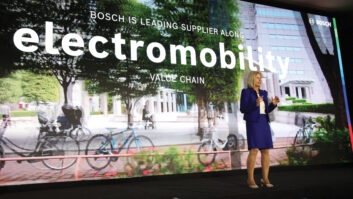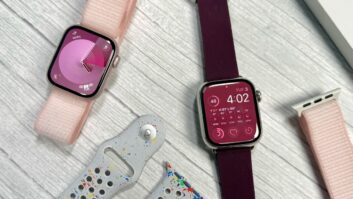LAS VEGAS – Are smart watches a sustainable new category or simply a fad that will fade? Will the Apple Watch be the category game changer? Will smart watches merge with fitness bands to create a single product category?
These were just some of the issues discussed at a wearables panel held at CTIA’s Super Mobility Week. The panel was moderated by TWICE senior editor Joseph Palenchar, who was joined by Eddie Hold, VP of Connected Intelligence at NPD; Steven Leeds, director of marketing at TigerDirect; and Timothy Dailey, national product manager at The Cellular Connection.
“We did an informal poll in Times Square recently,” Hold said of smart watches, “and we asked, ‘Would you buy this for $100?’ Many said yes, and the killer app was that it told the time.” After the laughter subsided, Hold added, “They liked that it told time so they didn’t have to pull their phones out of their pocket — and even though they were surrounded by vendors selling $2 watches.”
Based on his retail experience, TigerDirect’s Leeds sees some stickiness in the wrist wearables market. “We saw a particularly high return rate in the first year,” Leeds said. “First, users weren’t well-informed about the products. Second, they didn’t do what they thought they would do. And third, they bought them to use with the wrong device.”
But in a year, the retailer now stocks four times as many SKUs, its online store has experienced 12 times growth in searches, and the 30 percent return rate from 2013 has dropped to just 5 percent so far this year, he said. “Consumers are becoming more well-informed about knowing what they’re getting,” Leeds explained.
Leeds believes smart-watch growth presents a unique opportunity for brick-and-mortar retailers. “The product is hard to learn about unless you come in to touch and it and feel it,” Leeds said.
The Cellular Connection’s Dailey agreed that brick-and-mortar retailers are the best place for consumers to buy smart watches and wearables, but only if the retailer sells smart.
“We’re sitting down and having lengthy 45-minute conversations with customers,” Dailey reported. “It’s all about finding that thing about the customer to make the device sticky long term. We need to see customers upgrade their wearables like they do phones. It’s getting them into their hands and spending time and making the customer feel as if it’s something they need.”
All three panelists believe Samsung’s and Apple’s entries into the smart-watch business are nothing but good news, regardless of how good their products actually are.
“We saw a huge lift when Samsung got into the business,” Leeds said. “It sparked conversation.”
Do they need to get it right?” Dailey asked rhetorically about the Apple Watch. “They don’t have to. It will increase the overall excitement of the category, and that’s where the win will be for us.”
For his part, NPD’s Hold said, “It’s a beautiful device, but I don’t think it’s a compelling price, and it doesn’t do anything your phone won’t do.” Nonetheless, he said, “people will buy it. It will succeed because of or despite of its functionality.”
Long term, the panelists agreed that smart watches face several adoption problems such as short battery life and the lack of a compelling reason for anyone but an early adopter to buy one.
“Having to take your watch off every night and charge it — people will soon get tired of that,” Leeds believes. But both Apple and Samsung “have said the health-care system is the Holy Grail for wearable tech.”













